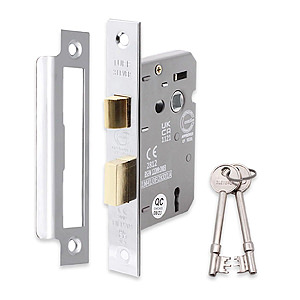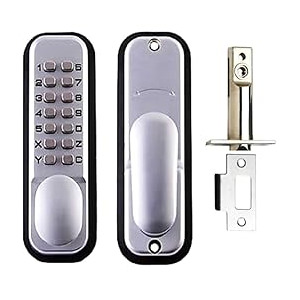
Introduction: Why Fire Door Locks Are Popular
Fire door locks might not be the first thing you think of when it comes to fire safety, but they're a critical part of the system. They ensure that fire doors stay shut when it matters most, keeping flames and smoke contained and helping to save lives.
Whether you're upgrading your home or working on a commercial project, these locks are an essential investment. This guide will walk you through what they are, the types available, and how to choose and care for them.
Understanding Fire Door Locks
What Are Fire Door Locks?
Fire door locks are specifically designed to keep fire doors secure during emergencies. Unlike standard locks, they're built to handle extreme heat without warping or failing. Their main job is simple but vital: to stop fire and smoke from spreading and give people more time to get out safely.
To ensure they perform under these conditions, these locks must meet strict safety standards like BS EN 12209. This British and European standard tests locks for durability, fire resistance, and load-bearing capacity. Compliance with BS EN 12209 guarantees the lock will hold up under pressure, offering peace of mind in residential and commercial buildings.
Common Materials

Fire door locks are made from strong materials that withstand heat and constant use.
Stainless steel is one of the most common choices because it's tough, resistant to rust, and perfect for high-humidity areas like kitchens or bathrooms. Brass is another popular choice, especially for places where appearance matters, as it's durable, stylish, and offers a timeless look.
You'll also find locks made from steel alloys, which provide excellent strength and performance at a slightly lower cost.
Many locks come with protective finishes, such as chrome, matte black, or polished brass. These finishes look great and add an extra layer of protection against wear and tear.
Types of Fire Door Locks

Mortice Fire Door LocksMortice fire door locks are recessed into the door, so they're secure and discreet.
Known for their strength and reliability, they are commonly used in fire doors across residential and commercial properties. These locks fit flush with the door and provide excellent fire protection without disrupting the overall design.
They're particularly suited for environments where durability and compliance are equally important.

Rim Fire Door LocksUnlike mortice locks, rim fire door locks are mounted on the door's surface. While they're more visible, they're quick to install and meet fire safety requirements.
Rim locks are a practical option for retrofitting older doors where cutting into the frame isn't ideal.

Deadlocks and DeadlatchesDeadlocks and deadlatches offer exceptional security and fire protection by ensuring doors stay firmly closed during a fire.
Deadlocks require manual locking and are ideal for areas where added security is needed, while deadlatches include a spring-loaded mechanism that automatically latches the door shut. These locks are commonly found in buildings with high foot traffic, where ensuring doors stay closed is critical.

Panic Exit LocksPanic exit locks are designed for one thing: easy evacuation. You'll often find these locks in schools, hospitals, offices, and other public buildings where a quick exit can make all the difference.
Push bars or lever systems make them simple to operate in emergencies, even for people unfamiliar with the door.

Classic StylesFor older buildings or homes with traditional designs, classic fire door locks combine safety with character. Polished brass mortice locks or traditional rim locks add a timeless look while still meeting fire safety standards. They're a great option for period properties where style and compliance matter.

Modern InnovationsModern fire door locks bring cutting-edge features into the mix. Electronic fire locks, for example, work with access control systems for added security. Smart fire locks take things further, letting you monitor or control doors remotely. Self-latching mechanisms are another smart innovation, ensuring doors close automatically to maintain fire safety standards.
These features are ideal for homes and businesses looking for safety and convenience.
Fire Door Lock Buying Guide
Key Factors to Consider
When buying fire door locks, the first thing to consider is the type of door you're securing.
For interior fire doors, mortice locks offer a clean, flush finish. If you're working with older doors or need an easier installation, rim locks are a great alternative. In public spaces, you'll need panic exit locks to ensure quick, safe evacuation.
The material is equally important. Stainless steel works best for durability and heat resistance, especially in areas exposed to moisture. Brass locks, while slightly pricier, offer a more decorative finish for style-conscious spaces.
Always check that the lock complies with BS EN 12209 so you know it will perform as expected during a fire.
Cost Comparison by Material and Style
The cost of these locks can vary depending on their material, type, and added features.
Standard mortice locks are often the most budget-friendly choice and work well for most doors. Rim locks fall into a mid-range price bracket and are perfect for retrofit projects. Deadlocks and deadlatches, with their added security features, come in slightly higher. If you're looking for modern solutions, electronic or smart fire locks sit at the premium end of the scale.
Spending a little more on certified, high-quality locks is always worth it. They last longer, perform better, and, most importantly, keep your fire doors compliant and reliable.
Maintenance Tips for Fire Door Locks
Cleaning and Care

These locks don't need much upkeep, but regular cleaning keeps them in tip-top shape.
Wipe them with a soft, damp cloth to remove dirt, dust, and grease. For stainless steel or polished finishes, a gentle cleaner will help maintain the shine without causing damage.
Avoid harsh chemicals, as they can corrode the surface and affect the lock's performance.
Handling Wear and Tear
With regular use, fire door locks can experience some wear and tear.
Check it periodically for loose screws or stiff operation. Tightening screws and applying a small amount of fire-safe lubricant usually does the trick. If a lock feels misaligned or fails to latch properly, address the issue quickly to ensure it remains fire-compliant.
Worn or damaged locks should always be replaced to keep your fire door in working order.
Energy Efficiency and Sustainability
Well-maintained fire door locks help improve energy efficiency by ensuring doors close tightly, reducing draughts and heat loss. Choosing locks made from durable materials like stainless steel or brass means fewer replacements, thus reducing waste over time.
Conclusion: Finding the Perfect Fire Door Lock
Locks are an essential part of any fire safety system, working hand in hand with fire doors to contain fire and smoke. From robust mortice locks to innovative panic exit systems, choosing the right lock ensures your fire doors perform as they should during emergencies.
This guide has provided the insights you need to understand the different types of fire door locks, their materials, and key features. By making informed choices and maintaining your locks properly, you're ensuring not only compliance but also safeguarding lives and property when every second counts.
Related Articles
Category
Doors & WindowsPosted On
30th January 2025



